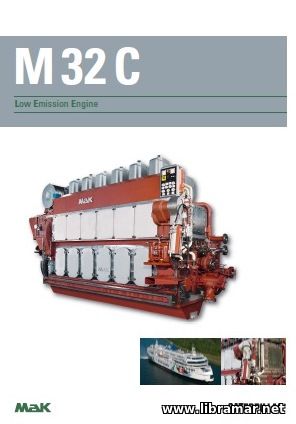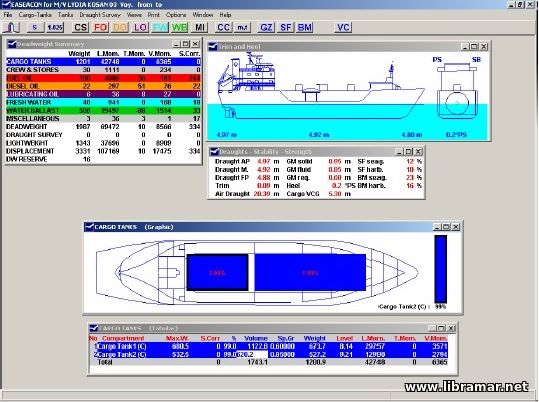Types of Pumps
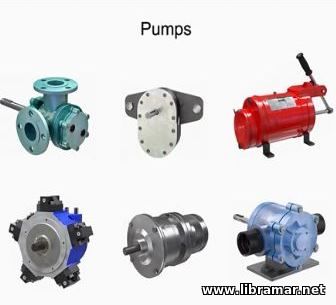
Many different types of pumps exist to assist fluid movement in a variety of systems.
External Gear Pump
An external gear pump uses two gears rotating against each other to provide fluid movement. One gear is driven by a motor connected to a shaft – this is called a drive gear because it is driven by a motor and it in turn meshes with and drives the movement of the second gear. As the gears rotate away from each other and come out of mesh, they create an expanding volume on the inlet 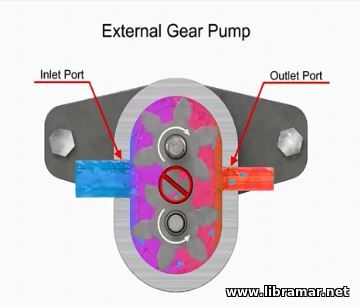 side of the pump.
side of the pump.
This creates vacuum at the inlet port, allowing fluid to flow into the pump. Then, fluid flows into the cavities and is trapped by the gear teeth. As the gears rotate, a flow path is created around the outside of each one. Fluid trapped in the slots between the teeth is carried around and discharged into the cavity with the outlet port. Meshing of the teeth in the center of the pump seals the outlet port from the inlet port – no fluid passes between the gears.
at their design accommodates wide variety of materials. Disadvantages include bushings in the liquid area can become worn and that they have fixed end clearances.
Internal Gear Pump
Internal gear pumps are exceptionally versatile. This type of pump has one inner gear which is inside a second, outer, gear. The inner gear has a shaft driven by a motor and has teeth that protrude outward. The outer gear has the teeth that protrude inward 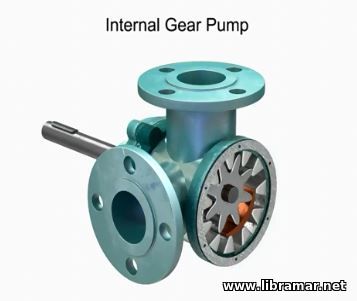 toward the center of the pump. As the inner gear rotates, it meshes with and moves the outer gear. Liquid is trapped in the gear spaces and carried from inlet to the discharge. A stationary crescent-shaped divider separates the intake and discharge portions of the fluid.
toward the center of the pump. As the inner gear rotates, it meshes with and moves the outer gear. Liquid is trapped in the gear spaces and carried from inlet to the discharge. A stationary crescent-shaped divider separates the intake and discharge portions of the fluid.
Advantages of internal gear pumps are their smooth and almost pulseless flow, and slightly more horse power for the size. Disadvantages are their cost, limited size range, low to moderate pressure ratings, and few sources of manufacture.
Rotary Vane Pump
A rotary vane pump is a positive displacement pump that consists of vanes, mounted to a rotor. The vanes are on a off-center drive shaft. As the shaft rotates, the 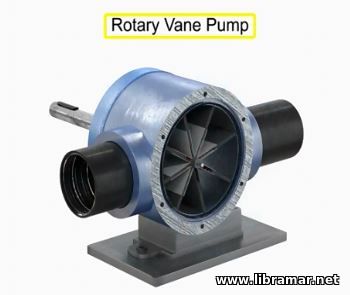 variable-length vanes slide in and out to maintain contact with the pump housing. The tension in the vanes is maintained by either springs or hydraulic pressure. As the vanes rotate, they create chambers of varying sizes within the pump. Fluid enters at the largest chamber. As the vanes rotate and retract, the chambers get smaller, forcing fluid to exit through the discharge port.
variable-length vanes slide in and out to maintain contact with the pump housing. The tension in the vanes is maintained by either springs or hydraulic pressure. As the vanes rotate, they create chambers of varying sizes within the pump. Fluid enters at the largest chamber. As the vanes rotate and retract, the chambers get smaller, forcing fluid to exit through the discharge port.
The advantages of vane pumps are that they can handle low viscosity fluids at relatively high pressures, can dry run for short periods, and develop a good vacuum. Their disadvantages include complexity and unsuitability for both high pressure and high viscosity fluids.
Piston Pumps
Piston pumps come in many different forms. A swash plate is a device used to translate the motion of the rotating shaft into 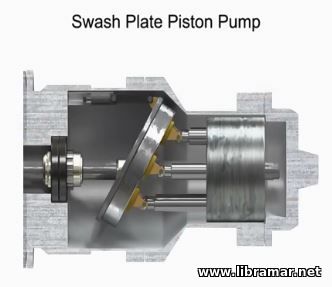 which are pressed against the stationary swash plate that sits at an angle to the cylinder. As the shaft rotates, the pistons move against the swash plate, causing them to reciprocate within the piston block. The pistons create a vacuum that forces fluid in during half a revolution, and expels during the other half.
which are pressed against the stationary swash plate that sits at an angle to the cylinder. As the shaft rotates, the pistons move against the swash plate, causing them to reciprocate within the piston block. The pistons create a vacuum that forces fluid in during half a revolution, and expels during the other half.
On the intake stroke a spring ensures the pistons is pulled back and maintains contact with the swash plate causing fluid to fill in the empty cavity left behind. On the discharge stroke the angle of the swash plate forces the pistons back inside the piston block and discharge the fluid. Piston pumps in general are manufacturer with closer internal fits than other pumps; this means that internal slippage can be less so that they operate within reasonable efficiency at pressures both too high and too low for the operation of other pumps.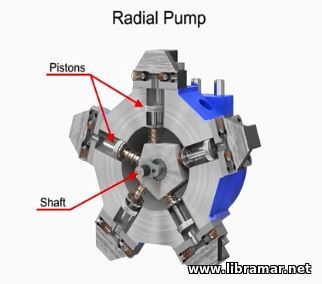
Radial Pumps
Radial pumps are designed so the piston stroke in a direction at right angles to the shaft. The pistons are arranged like wheel spokes around the cylinder block with the eccentric cam mounted on a drive shaft. As the shaft rotates, the cam moves toward the pistons forcing them down into the cylinder block and discharging the fluid. As the cam moves away, springs help retract the piston and cause the intake stroke. Check valves ensure that fluid only enters the inlet ports and only exits the outlet ports. Radial piston pumps have a low noise level, very high loads at low speeds, and high 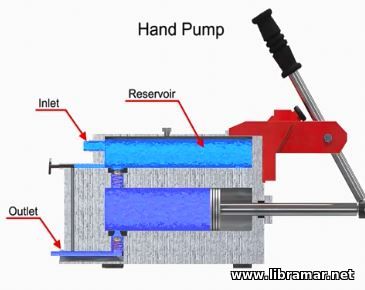 efficiency.
efficiency.
Hand Pumps
Hand pumps are used when a source of power is not available or where the extra expense of a power pump is unwarranted. They are always of piston type and are usually constructed with a piston working between two check valves. Double acting hand pumps are more efficient, allowing fluid to both enter and discharge on both strokes of the piston. Moving the pump handle in any direction allows fluid to be drawn in from the reservoir and discharged via the outlet ports. Check valves in all locations prevent fluid backflow.
The "Read Later" function allows you to add material to this block with just one click. Just click on the icon and read the articles that interest you at any convenient time.
